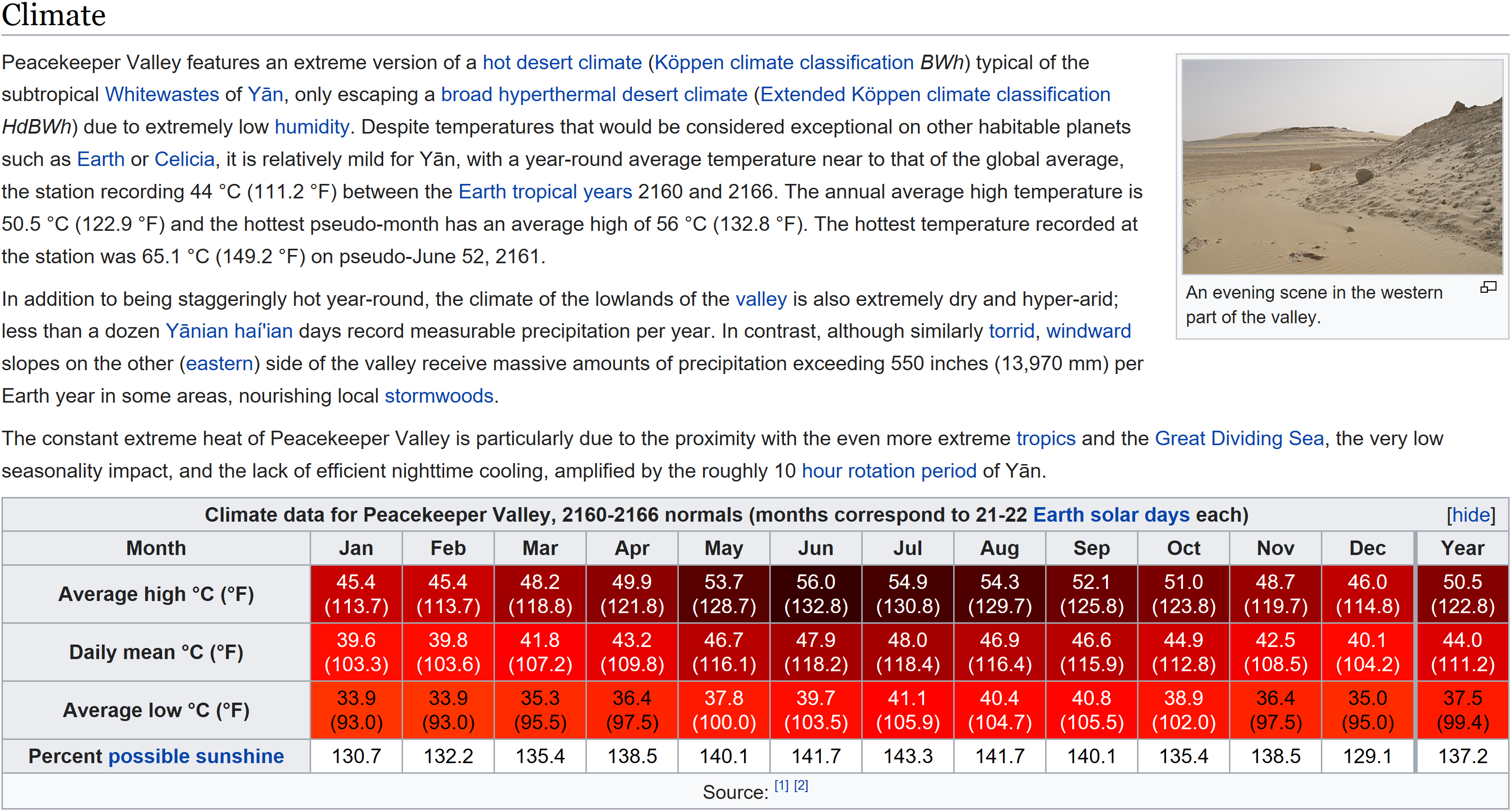HOME | DD
 GrantExploit — Celicia Universe: Peacekeeper Valley Climate
GrantExploit — Celicia Universe: Peacekeeper Valley Climate

#alternate #arid #celicia #climate #cthulhu #desert #fiction #hot #infobox #planet #scifi #sweltering #wikipedia #yan #chthonian #science_fiction #wikibox #alidancelec #yān #ali_dan_celec #fictional #sciencefiction #fictionalworld #celiciauniverse #celicia_universe
Published: 2019-01-21 03:28:23 +0000 UTC; Views: 530; Favourites: 4; Downloads: 1
Redirect to original
Description
(This is a slightly-edited version of this section as it existed in my User sandbox as of 2019-01-20 at 04:06 Coordinated Universal Time , with the section having originally been created on 2017-10-13 at 16:04 Coordinated Universal Time . Wow, that long ago?...) This is your typical, """temperate""" climate on Yān, the closest habitable planet to Haí. With average winter temperatures approximating the hottest average summer temperatures on Earth, and average summer temperatures approximating the hottest night and day temperatures ever experienced on Earth, with half of the year experiencing consistent century nights. More than 100% possible sunshine because it's located at 0.797 AU, meaning direct sunlight is 1.574 times more intense than that on Earth. Arid, because it's located away behind mountain ranges from the coasts of the oceans that thankfully make up only a small percentage of its non-polar regions.
Iven-Furrpaw , this is your (parent's) dream climate, right? Don't worry, if the temperatures aren't quite warm enough, there are plenty of hotter locations on the planet.
BTW, I am creating a greyscale drawing of a similar region to this, as my first landscape in 4 years. I don't expect perfect quality for that reason, but nonetheless it's a good restart.
If you have any questions or thoughts, please say 'em.
Related content
Comments: 11

Well, I registered an account on Wikipedia on 2015-08-12 and created a User sandbox page (an option available to all users) on 2016-06-22, then began adding stuff to it. I largely knew the syntax beforehand by looking at the source code of pages and seeing in the edit preview how changes affect the display of the article—it's very intuitive, but you'll probably want to look at a tutorial on how to do it first.
I used to do my "fake article sections" (between 2013 and 2017-03-10, when I started actually using the sandbox) by simply editing existing articles, screen-capturing the edit preview, and then clicking cancel, however that comes with the obvious weaknesses that you can't save the text and edit it later except through a separate utility and that it increases the chance of you accidentally submitting it as a real edit.
Because I didn't want the purple links of visited Wikipedia articles to show up for this—I made even the hyperlinks on fictional things direct to real articles 'cause I had to in order to get that effect—I opened the article in a browser I never use nobody likes you Edge to do the final screen-capture. Regarding images, you're limited to those on Wikipedia or Wikimedia Commons, though you can upload fictional pictures to relevant categories of fictional stuff on the latter as long as you're willing to make them public-domain, or paste over another image in post-processing. For the one in this section, I searched the "Desert" category on Commons to find the most suitable image.
The specific template used predominately in this section is Template:Weather box , but there are way more of these "infoboxes" available for different purposes (as I'm sure you know), which are mostly collected here .
👍: 0 ⏩: 1

Are there other sites in which I can make my own weather boxes besides Wikpedia? Or maybe Microsoft Excel has that kind of technology?
👍: 0 ⏩: 1

I dunno, maybe there's some wiki on Wikia with that functionality? Other than that, I doubt so.
Yes, you can create them on Microsoft Excel—in fact, my very first weather boxes in 2012-2013 were made on Excel—but it's very difficult to make them look convincing, given the particular borders, color schemes, etc. If you were to create an automatically-colored, perfect-looking template, I'm fairly sure that the effort from that (much of it from "research") would exceed just using the Wikipedia editor to create them—it's not hard. At least, I don't feel like it is now, nor did I feel like it was when I started.
BTW, I will get to your note.
👍: 0 ⏩: 0

That's quite extreme climate setting to choose :v
👍: 0 ⏩: 1

Well, this is only a typical climate on the innermost habitable planet of the Haí system, Yān. On the planet where all the sapient races originally come from (Celicia)... well, if a typical climate on Earth is Nashville, Tenessee, then that of Celicia would be Tallahassee, Florida.
👍: 0 ⏩: 1

Arizona: the planet
👍: 0 ⏩: 1

Sort of. Obviously, this climate is considerably more severe than any region on Earth, let alone Arizona—you get your Sonoran-style hot deserts between 45 and 75° latitude as well as very high, dry regions at lower latitudes (like the Changtang region of Tibet and the high southern Altiplano on Earth), though due to continentality and the blazing haí, the climate is often more akin to Turpan in terms of seasonal temperature variation—especially above 60°—and average summer temperatures may exceed the hottest in Arizona (96.85 °F in Lake Havasu City) in some areas as far as 70°.
Plus, Arizona doesn't have a coastline or any area that has an average annual precipitation greater than 39 in/yr🜨, while Yān does have oceans and places that exceed 1500 in/yr🜨, often due to the former (and often in particular due to the same phenomenon as to why any trees on many tropical coasts have trunks made of some exotic composite [silica-agar?]).
And there is a tiny region as well that is colder than anywhere Arizona, specifically the glaciers on the Mount Able Range near the North Pole.
👍: 0 ⏩: 0




























